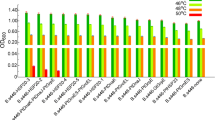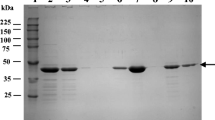Abstract
Bifidobacteria are probiotics that are incorporated live into various dairy products. They confer health-promotive effects via gastrointestinal tract colonization. However, to provide their health-beneficial properties, they must battle the various abiotic stresses in that environment, such as bile salts, acids, oxygen, and heat. In this study, Bifidobacterium longum salt- and heat-stress tolerance was enhanced by homologous overexpression of a small heat shock protein (sHsp). A positive contribution of overproduced sHsp to abiotic stress tolerance was observed when the bacterium was exposed to heat and salt stresses. Significantly higher survival of B. l ongum NCC2705 overexpressing sHsp was observed at 30 and 60 min into heat (55 °C) and salt (5 M NaCl) treatment, respectively. Thermotolerance analysis at 47 °C with sampling every 2 h also revealed the great potential tolerance of the engineered strain. Cell density and acid production rate increased for the sHsp-overexpressing strain after 8 and 10 h of both heat and salt stresses. In addition, tolerance to bile salts, low pH (3.5) and low temperature (4 °C) was also increased by homologous overexpression of the sHsp hsp20 in B. l ongum. Results revealed that hsp20 overexpression in B longum NCC2705 plays a positive cross-protective role in upregulating abiotic responses, ensuring the organism’s tolerance to various stress conditions; therefore, sHsp-overexpressing B. l ongum is advised for fermented dairy foods and other probiotic product applications.




Similar content being viewed by others
References
Alexander B, Ferdinand A, Thomas K, Nathalie B, Sevil W, Michael G, Martin H, Johannes B (2012) Alternative bacterial two-component small heat shock protein systems. Proc Natl Acad Sci USA 109(50):20407–20412
Alp G, Aslim B (2010) Relationship between the resistance to bile salts and low pH with exopolysaccharide (EPS) production of Bifidobacterium spp. isolated from infants feces and breast milk. Anaerobe 16:101–105
Argnani A, Leer RJ, van Luijk N, Pouwels PH (1996) A convenient and reproducible method to genetically transform bacteria of the genus Bifidobacterium. Microbiology 142:109–114
Begley M, Gahan CGM, Hill C (2005) The interaction between bacteria and bile. FEMS Microbiol Rev 29:625–651
Berger B, Moine D, Mansourian R, Arigoni F (2010) HspR mutations are naturally selected in Bifidobacterium longum when successive heat shock treatments are applied. J Bacteriol 192:256–263
Collado MC, Sanz Y (2006) Method for direct selection of potentially probiotic Bifidobacterium strains from human feces based on their acid-adaptation ability. J Microbiol Method 66:560–563
Coucheney F, Gal L, Beney L, Lherminier J, Gervais P, Guzzo J (2005) A small HSP Lo18, interacts with the cell membrane and modulates lipid physical state under heat shock conditions in a lactic acid bacterium. Biochim Biophys Acta Biomembr 1720:92–98
De Dea Lindne J, Canchaya C, Zhang ZD, Neviani E, Fitzgerald GF, van Sinderen D, Ventura M (2007) Exploiting Bifidobacterium genomes: The molecular basis of stress response. Int J Food Microbiol 120:13–24
Eylesa SJ, Gierasch LM (2010) Nature’s molecular sponges: Small heat shock proteins grow into their chaperone roles. Proc Natl Acad Sci USA 107(7):2727–2728
Flahaut S, Frere J, Boutibonnes P, Auffray Y (1996) Comparison of the bile salts and sodium dodecyl sulfate stress responses in Enterococcus faecalis. Appl Environ Microbiol 62:2416–2420
Guzzo J (2012) Biotechnical applications of small heat shock proteins from bacteria. Int J Biochem Cell Biol 44:1698–1705
Han MJ, Yun H, Lee SY (2008) Microbial small heat shock proteins and their use in biotechnology. Biotechnol Adv 26:591–609
Hofmann AF (1999) The continuing importance of bile acids in liver and intestinal disease. Arch Intern Med 159:2647–2658
Kim WS, Perl L, Park JH, Tandianus JE, Dunn NW (2001) Assessment of stress response of the probiotic Lactobacillus acidophilus. Curr Microbiol 43:346–350
Kitagawa M, Matsumura Y, Tsuchido T (2000) Small heat shock proteins, IbpA and IbpB are involved in resistances to heat and superoxide stresses in Escherichia coli. FEMS Microbiol Lett 184(2):165–171
Klijn A, Mercenier A, Arigoni F (2005) Lessons from the genomes of bifidobacteria. FEMS Microbiol Rev 29:491–509
Landry J, Chrétien P, Lambert H, Hickey E, Weber LA (1989) Heat shock resistance conferred by expression of the human HSP27 gene in rodent cells. J Cell Biol 101(1):7–15
Lee JH, O’Sullivan DJ (2010) Genomic insights into bifidobacteria. Microbiol Mol Biol Rev 74(3):378–416
Lorca GL, Font de Valdez G, Ljungh A (2002) Characterization of the protein synthesis dependent adaptive acid tolerance response in Lactobacillus acidophilus. J Mol Microbiol Biotechnol 4:525–532
Michelle C, Marco V, Gerald FF, van Douwe S (2011) Progress in genomics, metabolism and biotechnology of bifidobacteria. Int J Food Microbiol 149(1):4–18
Ouwehand AC, Salminen S, Isolauri E (2002) Probiotics: an overview of beneficial effects. Antonie Leeuwenhoek 82:279–289
Richter K, Haslbeck M, Buchner J (2010) The heat shock response: life on the verge of death molecular. Cell 40:253–266
Ruiz L, Patricia RM, Miguel G, Clara GDLR, Abelardo M, Sanchez Borja (2011) How do bifidobacteria counteract environmental challenges? Mechanisms involved and physiological consequences. Genes Nutr 6:307–318
Savijoki K, Suokko A, Palva A, Valmu L, Kalkkinen N, Varmanen P (2005) Effect of heat-shock and bile salts on protein synthesis of Bifidobacterium longum revealed by (35S) methionine labelling and two dimensional gel electrophoresis. FEMS Microbiol Lett 248:207–215
Schell MA, Karmirantzou M, Snel B, Vilanova D, Berger B, Pessi G, Zwahlen MC, Desiere F, Bork P, Delley M, Pridmore RD, Arigoni F (2002) The genome sequence of Bifidobacterium longum reflects its adaptation to the human gastrointestinal tract. Proc Natl Acad Sci USA 99(22):14422–14427
Schmidt G, Zink R (2000) Basic features of the stress response in three species of bifidobacteria: B. longum, B. adolescentis, and B. breve. Int J Food Microbiol 55:41–45
Schmittgen TD, Livak KJ (2008) Analyzing real-time PCR data by the comparative CT method. Nat Protoc 3:1101–1108
Ventura M, Canchaya C, Zhang Z, Bernini V, Fitzgerald GF, van Sinderen D (2006) How high GC gram-positive bacteria and in particular bifidobacteria cope with heat stress: protein players and regulators. FEMS Microbiol Rev 30:734–759
Ventura M, Canchaya C, Zhang Z, Fitzgerald GF, van Sinderen D (2007) Molecular characterization of hsp20, encoding a small heat shock protein of Bifidobacterium breve UCC2003. Appl Environ Microbiol 73:4695–4703
Xiao M, Xu P, Zhao J, Wang Z, Zuo F, Zhang J, Ren F, Li P, Chen S, Ma H (2011) Oxidative stress-related responses of Bifidobacterium longum subsp. longum BBMN68 at the proteomic level after exposure to oxygen. Microbiology 157:1573–1588
Zomer A, Fernandez M, Kearney B, Fitzgerald GF, Ventura M, van Sinderen D (2009) An interactive regulatory network controls stress response in Bifidobacterium breve UCC2003. J Bacteriol 191:7039–7049
Zuo FL, Feng XJ, Sun XF, Du C, Chen SW (2013) Characterization of plasmid pML21 of Enterococcus faecalis ML21 from koumiss. Curr Microbiol 66(2):103–105
Zuo FL, Yu R, Feng XJ, Khaskheli GB, Chen LL, Ma HQ, Chen SW (2014) Combination of heterogeneous catalase and superoxide dismutase protects Bifidobacterium longum strain NCC2705 from oxidative stress. Appl Microbiol Biotechnol 98:7523–7534
Zuo FL, Yu R, Khaskheli GB, Ma HQ, Chen LL, Zeng Z, Mao AJ, Chen SW (2014) Homologous overexpression of alkyl hydroperoxide reductase subunit C (ahpC) protects Bifidobacterium longum strain NCC2705 from oxidative stress. Res Microbiol 165:581–589
Acknowledgments
This work was funded by the National Natural Science Foundation of China (No. 31071507), the National High Technology Research and Development Program (“863” Program, No. 2008AA10Z310), and the National Science and Technology Support Program, Ministry of Science and Technology of China (2011BAD09B03).
Author information
Authors and Affiliations
Corresponding author
Rights and permissions
About this article
Cite this article
Khaskheli, G.B., Zuo, F., Yu, R. et al. Overexpression of Small Heat Shock Protein Enhances Heat- and Salt-Stress Tolerance of Bifidobacterium longum NCC2705. Curr Microbiol 71, 8–15 (2015). https://doi.org/10.1007/s00284-015-0811-0
Received:
Accepted:
Published:
Issue Date:
DOI: https://doi.org/10.1007/s00284-015-0811-0




